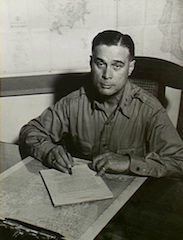At 5 a.m. I phoned Collector de Leon. His voice showed that he was worried. “I have not heard from the Apo”, he said, “I fear that it may have been sunk.” I decided to take other steps if no reply was received by 6:30 a.m.
At 6:30 a.m. I called up Mr. Jose (Peping) Fernandez one of the managers of Compañia Maritima and told him that I had to see him with an important problem. I rushed to his house. He realized my predicament. “I can offer you ships, but they are not here,” he said. After studying my needs from all angles we decided that the best thing to do would be to ask the U.S. Army to release the SS Mactan.
We contacted Colonel George, in charge of water transportation, and asked him to meet us at USAFFE Headquarters so that we could discuss the matter with General Marshall. We met at 8 a.m. and it was decided that the U.S. Army would release the Mactan to me to convert it into a hospital ship. I was told the SS Mactan, was in Corregidor and it would not be in Manila until after dark. I rushed to the Red Cross Headquarters and asked Mr. Forster to have the painters in readiness to start the painting without delay, as soon as the ship docked at Pier N-1.
Last night Mr. Forster sent a telegram to the American Red Cross in Washington informing them of our plan.
At 11 a.m. Collector de Leon phoned me that the Apo was sailing for Manila that evening. I thanked him and informed him that it was too late.
At 5 p.m. Mr. Wolff phoned me that they have received an important radiogram from the Secretary of State, Hull, and that my presence in the Red Cross was urgent to discuss the contents of this radiogram. I rushed there. Mr. Wolff, Mr. Forster, Judge Dewitt and Dr. Buss of the High Commissioner’s Office were already busy studying the contents of Mr. Hull’s radiogram. It was specified in it that the sending out of Red Cross hospital Ship was approved; that the Japanese government had been advised of its sailing through the Swiss Ambassador and that it was necessary that we radio rush the name of the ship and the route that would be followed. Moreover, we were told to comply strictly with the articles of the Hague convention of 1907. These articles define what is meant by Red Cross Hospital Ship, how it must be painted and what personnel it must carry. It clearly specifies that no civilian can be on the boat.
I left Red Cross Headquarters at 6:30 p.m. No news of the SS Mactan had been received. At 9 p.m. I called Dr. Canuto of the Red Cross, and I was advised that the ship had not yet arrived.
At 11 p.m. I went to Pier N-1 to inquire. No one could give me any information about the Mactan. There was a big fire in the Engineer Island. It had been bombed the previous day and the oil deposit took fire late this evening. The flames were very impressive. I left at 11:45 p.m.
